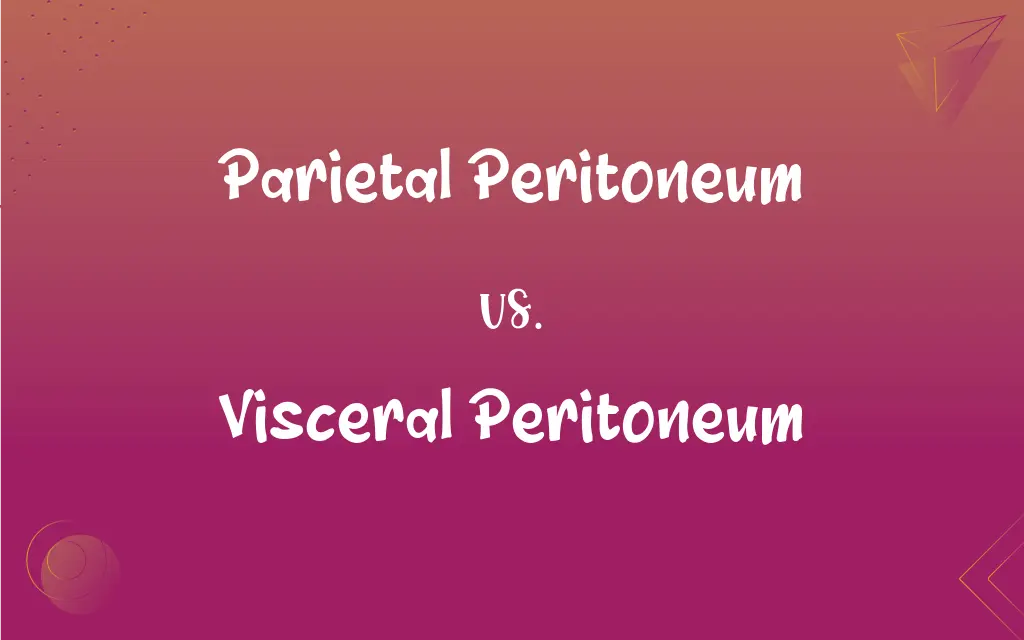Parietal Peritoneum vs. Visceral Peritoneum: What's the Difference?
Edited by Aimie Carlson || By Janet White || Published on February 27, 2024
The parietal peritoneum lines the abdominal wall; the visceral peritoneum covers the abdominal organs. Both are membranes within the abdominal cavity.

Key Differences
The parietal peritoneum is a serous membrane that lines the inner surface of the abdominal cavity. The visceral peritoneum, in contrast, covers the external surfaces of most abdominal organs, closely adhering to their contours.
The role of the parietal peritoneum includes reducing friction against the abdominal wall and providing a protective layer. The visceral peritoneum helps to protect and cushion the internal organs, facilitating smooth movements within the abdomen.
Sensation-wise, the parietal peritoneum is sensitive to pressure, pain, and temperature, serving as a pain receptor for the abdominal wall. The visceral peritoneum is less sensitive to pain and pressure, as it covers organs like the intestines and liver.
In terms of blood supply and nerve innervation, the parietal peritoneum has a rich blood supply and is innervated by somatic nerves. The visceral peritoneum has a different blood supply, typically from the vessels of the organs it covers, and is innervated by autonomic nerves.
In clinical terms, inflammation of the parietal peritoneum, known as peritonitis, often presents with localized, sharp pain. Inflammation of the visceral peritoneum typically causes more diffuse, generalized pain in the abdomen.
ADVERTISEMENT
Comparison Chart
Location
Lines the abdominal wall
Covers abdominal organs
Function
Reduces friction, provides protection
Cushions organs, facilitates movement
Sensitivity
Sensitive to pain, pressure, temperature
Less sensitive to pain and pressure
Blood Supply and Innervation
Rich blood supply, somatic nerves
Blood supply from organ vessels, autonomic nerves
Response to Inflammation
Localized, sharp pain (peritonitis)
Diffuse, generalized pain
ADVERTISEMENT
Parietal Peritoneum and Visceral Peritoneum Definitions
Parietal Peritoneum
A layer that ensures smooth movement against the abdominal wall.
The parietal peritoneum plays a crucial role in facilitating abdominal movements.
Visceral Peritoneum
A serous membrane covering the surfaces of abdominal organs.
The visceral peritoneum envelops organs like the liver and intestines.
Parietal Peritoneum
The protective layer against the abdominal wall.
Inflammation of the parietal peritoneum often results in sharp abdominal pain.
Visceral Peritoneum
Ensures smooth organ movement within the abdomen.
The visceral peritoneum allows the intestines to move freely during digestion.
Parietal Peritoneum
The part of the peritoneum that is supplied by somatic nerves.
The parietal peritoneum's somatic nerve supply explains the patient's sensation of pain.
Visceral Peritoneum
The membrane that provides cushioning for internal organs.
The visceral peritoneum helps to protect the organs from physical shock.
Parietal Peritoneum
A membrane sensitive to pain, pressure, and temperature.
The patient's pain was localized, indicating an issue with the parietal peritoneum.
Visceral Peritoneum
Supplied by autonomic nerves and organ-specific blood vessels.
The visceral peritoneum's blood supply is intricately linked to the organs it covers.
Parietal Peritoneum
A serous membrane lining the interior of the abdominal cavity.
The surgeon carefully avoided the parietal peritoneum during the procedure.
Visceral Peritoneum
Less sensitive to pain, covers the abdominal organs.
Inflammation of the visceral peritoneum may cause generalized abdominal discomfort.
FAQs
What is the visceral peritoneum?
A membrane covering abdominal organs.
What is the parietal peritoneum?
It's a membrane lining the abdominal wall.
What role does the visceral peritoneum play?
It cushions and supports the organs.
How do they respond to inflammation?
Parietal causes sharp pain, visceral causes diffuse pain.
How do the two peritoneums differ in location?
Parietal lines the wall, visceral covers organs.
What is the main function of the parietal peritoneum?
It protects and reduces friction against the wall.
Are both peritoneums sensitive to pain?
Parietal is sensitive; visceral is less so.
How are they innervated?
Parietal by somatic nerves, visceral by autonomic.
What is peritonitis?
Inflammation of the peritoneum, often painful.
Can both peritoneums get inflamed?
Yes, leading to different symptoms.
How do these membranes aid in organ function?
They facilitate smooth movement and protection.
How are problems with these peritoneums diagnosed?
Through symptoms, imaging, and sometimes surgery.
Can trauma affect these membranes?
Yes, leading to pain and potential complications.
Can diseases affect both peritoneums?
Yes, but they may manifest differently.
Do they have a role in abdominal surgeries?
Yes, their condition and treatment are crucial.
What's the blood supply like for each?
Parietal has its own supply; visceral is from organ vessels.
Do they have any regenerative capacity?
They can heal, but severe damage may have complications.
Is surgery on these peritoneums risky?
It requires care due to sensitivity and location.
Are there any specific diseases associated with each?
Peritonitis is common, with varied symptoms.
How important are they in overall abdominal health?
Vital for protection, movement, and organ function.
About Author
Written by
Janet WhiteJanet White has been an esteemed writer and blogger for Difference Wiki. Holding a Master's degree in Science and Medical Journalism from the prestigious Boston University, she has consistently demonstrated her expertise and passion for her field. When she's not immersed in her work, Janet relishes her time exercising, delving into a good book, and cherishing moments with friends and family.
Edited by
Aimie CarlsonAimie Carlson, holding a master's degree in English literature, is a fervent English language enthusiast. She lends her writing talents to Difference Wiki, a prominent website that specializes in comparisons, offering readers insightful analyses that both captivate and inform.






































































